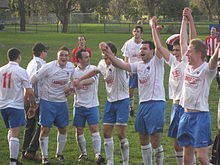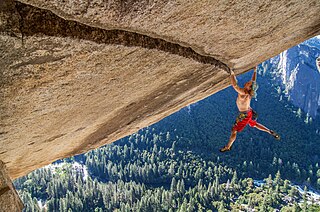
Climbing is the activity of using one's hands, feet, or other parts of the body to ascend a steep topographical object that can range from the world's tallest mountains to small boulders. Climbing is done for locomotion, sporting recreation, for competition, and is also done in trades that rely on ascension, such as construction and military operations. Climbing is done indoors and outdoors, on natural surfaces, and on artificial surfaces

Grappling is a fighting technique based on throws, trips, sweeps, clinch fighting, ground fighting and submission holds.
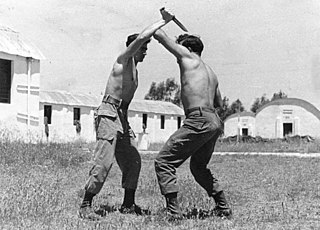
Krav Maga is an Israeli self-defence system. Developed for the Israel Defense Forces (IDF), it uses techniques derived from aikido, boxing, judo, karate and wrestling. It is known for its focus on real-world situations.

Martial arts are codified systems and traditions of combat practiced for a number of reasons such as self-defence; military and law enforcement applications; competition; physical, mental, and spiritual development; entertainment; and the preservation of a nation's intangible cultural heritage.

Professional wrestling is a form of athletic theater centered around mock combat and based on the premise that performers are competitive wrestlers. Professional wrestling is distinguished from amateur wrestling by its scripted outcomes and emphasis on entertainment and storytelling over genuine competition. The staged nature of matches is an open secret: Through a practice known as kayfabe, both wrestlers and spectators—as well commentators and journalists—maintain the pretense that the performances are bona fide competitions, which is likened to the suspension of disbelief employed when engaging with fiction.
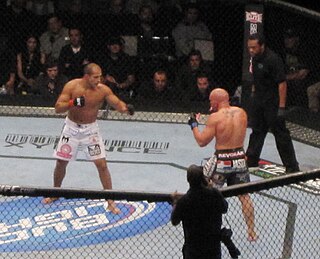
Mixed martial arts (MMA) is a full-contact fighting sport based on striking and grappling, incorporating techniques from various combat sports from around the world.

The épée, also rendered as epee in English, is the largest and heaviest of the three weapons used in the sport of fencing. The modern épée derives from the 19th-century épée de combat, a weapon which itself derives from the French small sword.
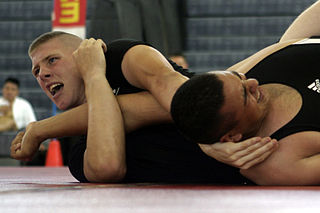
Submission wrestling, also known as submission grappling, submission fighting, or simply grappling, is a martial art and combat sport that focuses on ground fighting and submission techniques. It is a hybrid discipline that incorporates elements of various martial arts such as various wrestling styles, judo, and Brazilian jiu-jitsu. Submission wrestling is practiced both as a competitive sport and as a training method for self-defence and mixed martial arts (MMA).

Wrestling is a martial art and combat sport that involves grappling with an opponent and striving to obtain a position of advantage through different throws or techniques, within a given ruleset. Wrestling involves different grappling-type techniques, such as clinch fighting, throws and takedowns, joint locks, pins, and other grappling holds. Many different wrestling techniques have been incorporated into martial arts, combat sports, and military systems.

Rock climbing is a climbing sports discipline that involves ascending routes consisting of natural rock in an outdoor environment, or on artificial resin climbing walls in a mostly indoor environment. Routes are chronicled in guidebooks, and on online databases, with the details of how to climb the route, and who made the first ascent and the coveted first free ascent. Climbers will try to ascend a route onsight, however, a climber can spend years projecting a route before they make a redpoint ascent.

Sambo is a combat sport, and a recognized style of amateur wrestling governed by the UWW in the World Wrestling Championships along with Greco-Roman wrestling and freestyle wrestling. Practiced worldwide, sambo is a martial art with Soviet origins. Many of its moves have been incorporated in other forms of combat sport such as mixed martial arts.

Wushu, or kung fu, is a competitive Chinese martial art. It integrates concepts and forms from various traditional and modern Chinese martial arts, including Shaolin kung fu, tai chi, and Wudangquan. "Wushu" is the Chinese term for "martial arts", reflecting the art's goal as a compilation and standardization of various styles. To distinguish it from Traditional Chinese Martial Arts, it is sometimes referred to as 'Modern Wushu'.

Catch wrestling is an English wrestling style where wrestlers aim to win by pinning or submitting their opponent using any legal holds or techniques. It emphasizes adaptability and seizing opportunities during the match, with fewer restrictions than other wrestling styles - techniques using or targeting the legs are allowed, submissions are allowed, and there are no mandatory grips. It was spread by wrestlers of travelling funfairs who developed their own submission holds, referred to as "hooks" and "stretches", into their wrestling to increase their effectiveness against their opponents, as well as immigrants through Europe and the Anglosphere.
In sport, a championship is a competition in which the aim is to decide which individual or team is the champion.

Pahlevani and zourkhaneh rituals is the name inscribed by UNESCO for varzesh-e pahlavāni or varzesh-e bāstāni, a traditional system of athletics and a form of martial arts originally used to train warriors in Iran (Persia) Outside Iran, zoorkhanehs can now also be found in Azerbaijan, and Afghanistan, and were introduced into Iraq in the mid-19th century by the Iranian immigrants, where they seem to have existed until the 1980s before disappearing. It combines martial arts, calisthenics, strength training and music. It contains elements of pre-Islamic and post-Islamic culture of Iran with the spirituality of Persian Shia Islam and Sufism. Practiced in a domed structure called the zurkhāneh, training sessions consist mainly of ritual gymnastic movements and climax with the core of combat practice, a style of folk wrestling called koshti pahlavāni.

Although the earliest evidence of martial arts goes back millennia, the true roots are difficult to reconstruct. Inherent patterns of human aggression which inspire practice of mock combat and optimization of serious close combat as cultural universals are doubtlessly inherited from the pre-human stage and were made into an "art" from the earliest emergence of that concept. Indeed, many universals of martial art are fixed by the specifics of human physiology and not dependent on a specific tradition or era.
Underwater sports is a group of competitive sports using one or a combination of the following underwater diving techniques - breath-hold, snorkelling or scuba, usually including the use of equipment such as diving masks and fins. These sports are conducted in the natural environment at sites such as open water and sheltered or confined water such as lakes and in artificial aquatic environments such as swimming pools. Underwater sports include the following - aquathlon, finswimming, freediving, spearfishing, sport diving, underwater football, underwater hockey, underwater ice hockey, underwater orienteering, underwater photography, underwater rugby, underwater target shooting and underwater video.

Sport is a form of physical activity or game. Often competitive and organized, sports use, maintain, or improve physical ability and skills. They also provide enjoyment to participants and, in some cases, entertainment to spectators. Many sports exist, with different participant numbers, some are done by a single person with others being done by hundreds. Most sports take place either in teams or competing as individuals. Some sports allow a "tie" or "draw", in which there is no single winner; others provide tie-breaking methods to ensure one winner. A number of contests may be arranged in a tournament format, producing a champion. Many sports leagues make an annual champion by arranging games in a regular sports season, followed in some cases by playoffs.
Openweight, also known as Absolute, is an unofficial weight class in combat sports and professional wrestling. It refers to bouts where there is no weight limit and fighters with a dramatic difference in size can compete against each other. It is different from catch weight, where competitors agree to weigh in at a certain amount without an official weight class. While weight classes are usually mandatory now, openweight competition was the norm for combat sports since antiquity and continues into the modern day.

The Canadian Equestrian Team or CET collectively describes the athletes that represent Canada at the highest levels of international equestrian competition, specifically at the World Championship, Olympic, and Paralympic levels.

